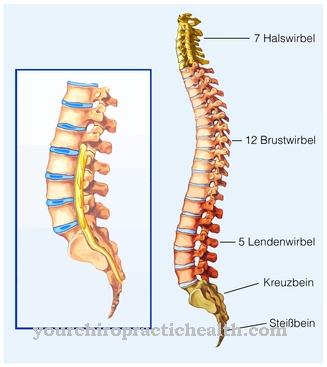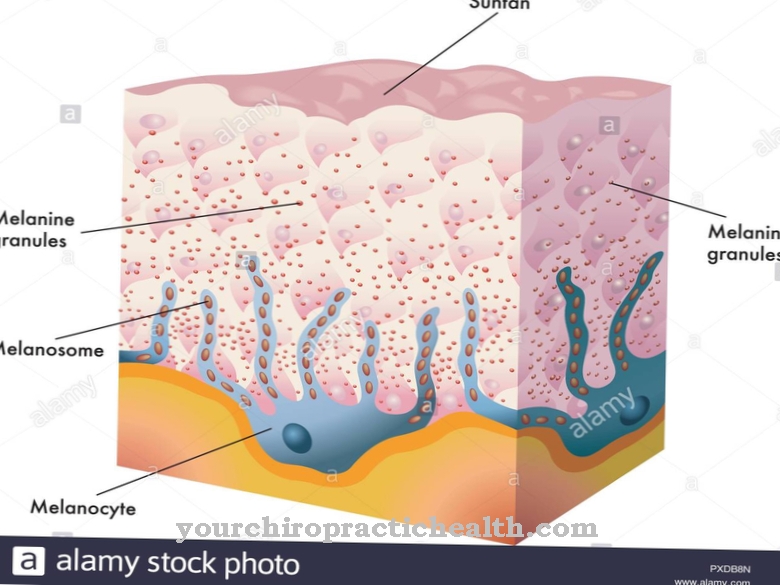The Maxillary sinus is part of the sinus system. The scientific name Maxillary sinus goes back to the Latin language. Medical terminology also uses the synonym Maxillary sinus. The maxillary sinus has paired pneumatization spaces (cavities) in the upper jawbone (maxilla) equipped with respiratory ciliated epithelium.
What is the maxillary sinus?
The maxillary sinus runs laterally on both sides of the main nasal cavity in the upper jawbone (maxilla) and fills this almost completely. It is one of the largest sinuses. It is connected to the main nasal cavity via an opening in the shape of a crescent (Hiatus semilunaris). This is located just below the middle turbinate (Concha nasi media). Starting from the maxillary sinuses, the drainage point is located quite high up, which makes the transport of secretions, for example runny nose, more difficult.
The zygomatic bone delimits the sinuses. Inflammation of the maxillary sinuses (maxillary sinusitis) affects the paranasal sinuses particularly badly. The maxillary sinus is part of a system made up of five paranasal sinuses: the frontal sinus (sinus frontalis), ethmoid cells (callulae ethmoidales, arranged above the eyes), maxillary sinus (on both sides of the nose up to the jawbone), sphenoid sinus (sinus sphenoidalis, above the nose, between the eyes), thin septum (septum sinuum frontalium, in the middle of the frontal sinus).
Anatomy & structure
As part of the paranasal sinuses, the maxillary sinus has the shape of a three-sided pyramid. The floor of the maxillary sinus is about one centimeter lower than the floor of the nose. Their maximum volume is 15 cm3. The walls are equipped with respiratory (breathable) flicker rephitel.
The maxillary sinus has various bulges, which are known in technical terms as recesses. In the depression of the basal section, individual parts of the tooth roots can protrude into the lumen (diameter, the inside of a cavity), which are covered exclusively by the mucous membrane. The scientific name for this bulge is recessus aveolaris. The second bulge, the zygomatic recess (junction), lies laterally limited to the oszygomaticum (zygomatic bone). The maxillary sinus borders cranially (upwards) on the orbita (eye socket), dorsally (on the back) on the alar palate group (pterygopalatine fossa), caudally (downwards) on the maxillary teeth and the hard palate (palatum durum) and medially on the inferior nasal concha (lower turbinate) and the nasal cavity.
The medial wall consists mainly of cartilage tissue. The maxillary sinus is located in the upper jawbone and is connected to the nasal cavity via an opening. The roots of the upper posterior teeth are located on the floor of the maxillary sinus. These are separated from the maxillary sinus by a thin bone lamella. On this bone lamella is the mucous membrane of the maxillary sinus, through which the infraorbital nerve (direct continuation of the maxillary nerve) runs in a bony canal and exits below the eye. The position of the ostium (opening of the medial wall of the maxillary sinus) prevents the drainage of mucus when the head is upright.
Function & tasks
Medically, the function of the maxillary sinus is not yet fully understood. The paired bulges in the nasal cavity are filled with air and lined with mucous membrane. They are part of the respiratory system, so they are involved in warming and humidifying the air, enhancing the resonance of the voice and in the sense of smell. The tasks of the paranasal sinuses include conditioning the air we breathe and enlarging the nasal cavity.
The paranasal sinuses and thus their largest component, the maxillary sinus, are lined with a mucous membrane (mucosa) covered with cilia. These move with a time delay like a wheat field in the wind and transport the mucus on the hairs into the nasopharynx. As a result, pathogens and pollutants are swallowed and neutralized by the acidic environment of the stomach. The nasal cavity system also has an insulating function. Since the formation of cavities saves bone material, the paranasal sinuses reduce the weight of the skull.
You can find your medication here
➔ Medicines for colds and nasal congestionDiseases
The most common condition is maxillary sinus infection, which causes general pain and pressure in the head, under the eyes, and in the upper jaw. If the course is chronic, these symptoms remain for several weeks. The most unpleasant side effects are toothache in the upper jaw that is not limited to one tooth, as these complaints spread to the posterior teeth of the upper jaw at the same time. The roots of these posterior teeth lie directly under the mucous membrane of the maxillary sinus.
The tooth nerves are distributed through a thin network of fine branches on the floor of the maxillary sinus. If inflammation or fluid accumulation occurs, or if the mucous membrane is swollen, this abnormal course presses on the fine nerve fibers located there. The nerves transmit the incoming pressure to the teeth in the form of a toothache. The pain in the teeth can be stronger than the discomfort at the place of origin of the maxillary sinus. Sinusitis is not solely caused by a viral or bacterial infection through the nose. If the tips of the roots of the upper posterior teeth are inflamed, this inflammation can spread to the mucous membrane.
Cysts (chronic inflammation) or granulomas on the devitalized (dead) teeth are able to dissolve the thin bone lamella between the maxillary sinus and the tooth root and to spread in the maxillary sinus. In many patients, this process is initially painless and occurs as an incidental finding of an X-ray examination.
If the inflammation originates in a tooth, this causative tooth must be treated by apicectomy or root canal treatment. An acute viral or bacterial infection of the maxillary sinus must be treated by an ear, nose and throat specialist or an internist. Possible etiologies are propagated periodontal (tooth support apparatus) or periapical (via the root canal) infections, mouth and atrum connections, foreign bodies and cysts.
The following complications can occur:
- Orbital phlegmon / abscess,
- Sinus Cavernosus Thrombosis,
- Brain abscess / epidural abscess,
- Osteomyelitis (infectious inflammation of the bone marrow)
- chronic pain
An excellent therapeutic approach is also the osteopathic (complementary medical procedure) treatment. Allergic diseases such as hay fever can also cause acute symptoms. Systemic diseases with involvement of the paranasal sinuses, for example tumor diseases, also occur frequently.













.jpg)

.jpg)
.jpg)











.jpg)